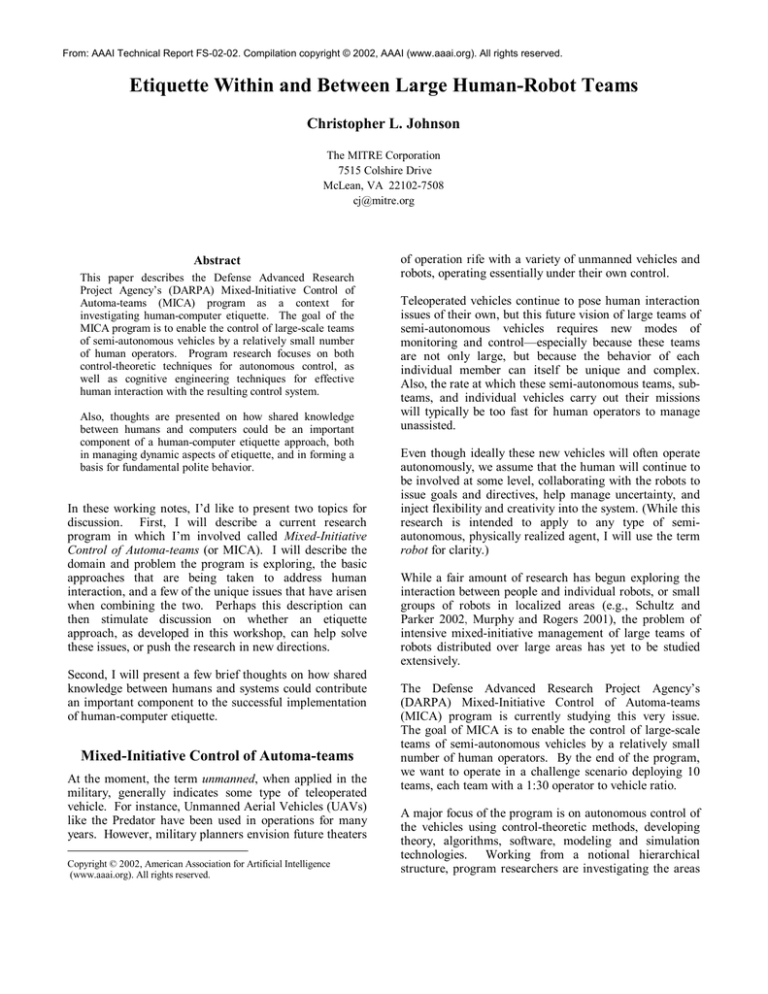
From: AAAI Technical Report FS-02-02. Compilation copyright © 2002, AAAI (www.aaai.org). All rights reserved.
Etiquette Within and Between Large Human-Robot Teams
Christopher L. Johnson
The MITRE Corporation
7515 Colshire Drive
McLean, VA 22102-7508
cj@mitre.org
Abstract
This paper describes the Defense Advanced Research
Project Agency’s (DARPA) Mixed-Initiative Control of
Automa-teams (MICA) program as a context for
investigating human-computer etiquette. The goal of the
MICA program is to enable the control of large-scale teams
of semi-autonomous vehicles by a relatively small number
of human operators. Program research focuses on both
control-theoretic techniques for autonomous control, as
well as cognitive engineering techniques for effective
human interaction with the resulting control system.
Also, thoughts are presented on how shared knowledge
between humans and computers could be an important
component of a human-computer etiquette approach, both
in managing dynamic aspects of etiquette, and in forming a
basis for fundamental polite behavior.
In these working notes, I’d like to present two topics for
discussion. First, I will describe a current research
program in which I’m involved called Mixed-Initiative
Control of Automa-teams (or MICA). I will describe the
domain and problem the program is exploring, the basic
approaches that are being taken to address human
interaction, and a few of the unique issues that have arisen
when combining the two. Perhaps this description can
then stimulate discussion on whether an etiquette
approach, as developed in this workshop, can help solve
these issues, or push the research in new directions.
Second, I will present a few brief thoughts on how shared
knowledge between humans and systems could contribute
an important component to the successful implementation
of human-computer etiquette.
Mixed-Initiative Control of Automa-teams
At the moment, the term unmanned, when applied in the
military, generally indicates some type of teleoperated
vehicle. For instance, Unmanned Aerial Vehicles (UAVs)
like the Predator have been used in operations for many
years. However, military planners envision future theaters
Copyright © 2002, American Association for Artificial Intelligence
(www.aaai.org). All rights reserved.
of operation rife with a variety of unmanned vehicles and
robots, operating essentially under their own control.
Teleoperated vehicles continue to pose human interaction
issues of their own, but this future vision of large teams of
semi-autonomous vehicles requires new modes of
monitoring and control—especially because these teams
are not only large, but because the behavior of each
individual member can itself be unique and complex.
Also, the rate at which these semi-autonomous teams, subteams, and individual vehicles carry out their missions
will typically be too fast for human operators to manage
unassisted.
Even though ideally these new vehicles will often operate
autonomously, we assume that the human will continue to
be involved at some level, collaborating with the robots to
issue goals and directives, help manage uncertainty, and
inject flexibility and creativity into the system. (While this
research is intended to apply to any type of semiautonomous, physically realized agent, I will use the term
robot for clarity.)
While a fair amount of research has begun exploring the
interaction between people and individual robots, or small
groups of robots in localized areas (e.g., Schultz and
Parker 2002, Murphy and Rogers 2001), the problem of
intensive mixed-initiative management of large teams of
robots distributed over large areas has yet to be studied
extensively.
The Defense Advanced Research Project Agency’s
(DARPA) Mixed-Initiative Control of Automa-teams
(MICA) program is currently studying this very issue.
The goal of MICA is to enable the control of large-scale
teams of semi-autonomous vehicles by a relatively small
number of human operators. By the end of the program,
we want to operate in a challenge scenario deploying 10
teams, each team with a 1:30 operator to vehicle ratio.
A major focus of the program is on autonomous control of
the vehicles using control-theoretic methods, developing
theory, algorithms, software, modeling and simulation
technologies. Working from a notional hierarchical
structure, program researchers are investigating the areas
of team composition, inter-team coordination, cooperative
path-planning, and uncertainty management.
However, the mixed-initiative issues involved in including
humans in the control process are an equally important
focus of the program. For instance, how can the system
support meaningful collaboration between human decision
makers and teams of autonomous entities that are
operating from complex control algorithms in complex
and uncertain environments? How is the performance,
stability, and robustness of the system affected when an
operator can take control at varying levels and at varying
times? Explicitly considering human interaction issues
simultaneously with technology development is
historically rare in these kinds of research programs, and
it has worked very well so far in the year since MICA
began.
Distinguishing Features
Listed below are a few of the distinguishing features—
considered as a group—of the MICA domain:
Humans interact with physical agents
The number of robots is large
Each individual robot possesses its own complex
behavior
Humans and robots are distributed over a large area
Humans can be supervisors as well as peer members of
teams
Underlying autonomous control is complex, likely
difficult for human to understand on their own
A potential exists for highly fluid team tasking and
structure
Operations occur in a military context
Operations occur in the presence of adversarial behavior
Situational events could occur at high speed
The challenge program for the MICA program
concentrates on controlling teams of UAVs in a
Suppression of Enemy Air Defense (SEAD) scenario. In
other words, operators will be using semi-autonomous,
armed UAVs to prepare a battlefield for air operations by
incapacitating enemy radar, surface-to-air missiles
(SAMs), communication links, etc. However, MICA
research is intended to generalize to any domain involving
autonomous team behavior, such as search and rescue,
environmental exploration, etc.
As an example, an interesting issue that appears in
operator interaction with autonomous control techniques is
that of predictability and expectations. A standard
concept in human-computer interaction design is
consistency. However, in an adversarial environment,
predictable behavior is often the last thing we want.
Furthermore, one of the hopes for control-theoretic
techniques is the discovery of new behaviors. Researchers
will need to find the right levels between consistency,
unpredictability, and explanation that will still allow a
human operator to understand what the control system is
doing at any given time.
In such an environment, with physical agents performing
combat-related tasks in real-time in the real world,
etiquette concerns such as safety, trust, and efficiency of
interaction are critical.
Mixed-Initiative Approaches
The MICA program was structured so that control
engineers were required to form research teams with
cognitive engineers, and work closely together in
integrating the needs of the human operator with the
developing control technology. My role on the program is
as a member of the DARPA management team, advising
program management on issues of supervisory control and
cognitive engineering. Therefore, this section simply
provides an overview of the kinds of mixed-initiative
approaches the research teams are applying to the MICA
problem.
The core of each approach is a traditional cognitive
engineering analysis of the domain (Roth, Patterson, and
Mumaw 2001), determining the kinds of information and
control decisions that human operators will need to
successfully interact with these large teams of robots. One
interesting issue we’ve encountered is that we’re applying
these techniques to a hypothetical rather than an existing
domain. Researchers can gather insight from UAV
experts, current military operations experts, future military
operations experts, perhaps experts in similar domains
(e.g., air traffic controllers), but they have no access to
experts with extensive experience in managing large
teams of robots.
One group has created a baseline interface containing the
kinds of information a control theorist wants to see. They
then plan to work from there, putting the interface in front
of more operational users and using their responses to
improve the design. Another group has explored ways to
visualize the operation of specific control technologies,
such as policies for partially-observable Markov Decision
Processes.
Others are looking at creating knowledge models with the
information they gather from cognitive engineering
analysis and using those models to drive components of
the interaction. For instance one group is building an
interaction design based around the metaphor of a
playbook, where the user can control a team by selecting
‘plays’, adjusting the details as much or as little as needed.
Another group is using a model of the tasks, roles,
domain, and interactions to automatically generate
displays that are appropriate to the current user and
situation.
Evaluation
An obvious approach to evaluating the results of MICA
research is to score the end results of a team’s
performance in the challenge problem. For instance, how
many SAM sites were destroyed? How many team
members were lost? How many collateral objects were
hit? This technique is commonly used because the results
are easily quantified. This is in fact one of the evaluations
that will be used in the MICA program.
Because humans will be integral to the control process, we
can also employ cognitive engineering techniques to
analyze characteristics such as the workload of the
operator, and their acceptance of the system. We also
want to evaluate the effect of the operator on the control
concepts of performance, stability, and robustness.
Another interesting issue arises when trying to combine
control engineering and cognitive engineering evaluation
techniques. Control algorithms are usually tested by
running large numbers of simulations—putting human
subjects through thousands of simulation runs is not a
viable option. Some combination of the two techniques
will be need to be developed.
Besides these standard approaches to metrics and
evaluation, an additional avenue we are considering is to
apply evaluation ideas from the organizational/social
science team performance literature (Brannick, Salas, and
Prince 1997) to human-robot team evaluation.
Specifically, can we evaluate the quality of the team’s
process in addition to the end results? This need is a
common theme throughout team performance literature.
Perhaps the team achieved all of its objectives, but only
because of luck—perhaps the team failed, even though it
performed perfectly. Developing metrics for team process
is also important for finding ways to improve
performance, not simply deciding whether the team
succeeded or failed.
Researchers have generally compiled team process metrics
into several broad categories of competencies that effective
teams possess: knowledge, skills, attitudes, leadership,
decision-making, etc. Because a portion of team process
involves interacting with teammates, many of these
competencies appear relevant to the issue of etiquette
evaluation as well. For instance, what is the quality of
communication within and between teams? What is the
rate of correct information? What are the ratios of
statement types made between members? How complex is
the information communicated? In terms of etiquette
design, does the etiquette improve or hinder assertiveness:
that is, do team members confront ambiguities and
uncertainties, make suggestions, maintain their position
when challenged? Does the etiquette improve or hinder
feedback and backup behaviors? (Feedback encourages
action from another team member, backup proactively
fixes the problem.)
Like etiquette, the study of team performance also
concerns issues of trust and efficiency; perhaps knowledge
from this field can also be applied to the study of humancomputer etiquette.
Etiquette Questions
I’ve briefly described the MICA domain and some of the
issues that we’ve been exploring. Below are a few
additional brainstorming questions relevant to this
workshop:
Are there limitations in MICA’s current approaches to
addressing mixed-initiative control that an etiquette
approach could improve upon?
What would an etiquette for the MICA domain look
like? Are there fundamental differences in this and
etiquettes for other domains?
Are there fundamental differences in the etiquette
design process for this domain vs. other domains?
Can we characterize the features of an etiquette and use
this characterization to determine exactly how the
etiquette is affecting human-computer performance?
For instance, how is a MICA etiquette specifically
affecting performance, stability, and robustness of the
control system?
Is it useful to consider designing etiquette into interagent interactions in the same way that we’re thinking
about human-computer etiquette? If so, how can this
also benefit the larger human-team etiquette?
Contribution of Shared Knowledge
to Etiquette
More generally, I am also particularly interested in what
role shared knowledge can play in designing and
implementing human-computer etiquette. By shared, I
mean knowledge shared between the human and the
computer, in forms that both can understand.
One area where shared knowledge could contribute is in
managing the more dynamic aspects of human-computer
etiquette. Knowing the rules of etiquette in a given
situation is important, but also important is detecting
changes or variations in a situation, learning new
situations, dealing with breaches and exceptions, etc. If
we were to implement a more dynamic etiquette, what
types of situations should we represent, and at what level?
How should we represent them? How can the computer
detect a change to the current etiquette context? How can
the computer best convey to users a change in its
perceived situation, or reasons for behaving contrary to the
current etiquette, and vice versa?
Working from a more naïve, informal meaning of
etiquette as formalized polite behavior, another area where
shared knowledge might contribute is in providing a
stronger foundation for politeness or novel etiquette.
Assuming that a basis for polite behavior is anticipating
the needs and goals of others you’re interacting with, and
assisting those needs (even occasionally at the expense of
your own needs and goals), then shared knowledge
between the human and computer can provide a
foundation for predicting what kinds of information or
direction the other will need next.
Acknowledgements
For more information about the MICA program, please
see http://www.darpa.mil/ixo/mica.asp.
The MICA
Program Manager is LTC Sharon Heise. Major cognitive
engineering researchers who have worked on the mixedinitiative aspects of MICA, including the techniques
described above, are Aptima, BBN, Charles River
Analytics, Honeywell, Iterativity, Micro Analysis and
Design, and SIFT.
References
Brannick, M.T., E. Salas, & C. Prince, eds. 1997. Team
Measurement and Performance: Theory, Methods, and
Applications. Mahway, NJ: Lawrence Erlbaum Associates.
Murphy, Robin R. and Erika Rogers. 2001. Final Report
for DARPA/NSF Study on Human-Robot Interaction.
Available at http://www.aic.nrl.navy.mil/hri/nsfdarpa/ .
Schultz, Alan C. and Lynne E. Parker, eds. 2002. MultiRobot Systems: From Swarms to Intelligent Automata—
Proceedings from the 2002 NRL Workshop on MultiRobot Systems. Boston: Kluwer Academic Publishers.
Roth, Emilie M., Emily S. Patterson, and Randall J.
Mumaw. 2001. Cognitive Engineering: Issues in UserCentered System Design. Encyclopedia of Software
Engineering, 2nd Edition, J.J. Marciniak (Ed.). New
York: Wiley-Interscience.





